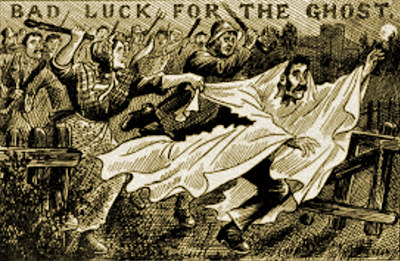Fake History in the Cemetery

There seems to be quite a lot of misinformation circulating about the history of South Brisbane Cemetery. We have met numerous people who have been told false information about the place, or have read it somewhere.
This is not about mistakes involving names or dates, or absurd ghost stories. This is about stories of things that simply never happened, and for which there is no acceptable evidence (‘somebody told me’ is not evidence). One of our missions is to ensure that the historical integrity of the cemetery is protected, and so we aim to debunk this ‘fake history’ whenever we encounter it. We base all our information as presented in tours, talks and publications on a critical and honest analysis of the historical record. This is why they are presented as being ‘Real History’. Unfortunately, some of the fake history is being deliberately perpetuated. Some examples relating to South Brisbane Cemetery are listed below.
If you have been told that any of the following stories are true, you have been misled.
Cemetery morgue
People have been told that there was a morgue in the cemetery, where the current office/lunch room is (next to the toilets).
This is a false claim. There is no historical evidence of a morgue ever being in the cemetery.
Selina Brown
Selina was a young girl who drowned in South Brisbane during a river flood in 1890. She had been swimming with a young man in a flooded yard, who failed to save her from drowning after she got into difficulties. Some people have been given the false impression that Selina’s death may have been the result of ‘foul play’, as ‘finger marks were found on her neck’ during the post-mortem.
There is no historical evidence to support this claim of ‘foul play’. A Magistrate’s Inquiry found that the cause of her death was drowning, and was specifically told that there were no marks of violence on the body.
‘The Devil’s Plot’
This name has been circulated in recent years in connection to section 6B, where executed prisoners were interred during 1883-1913.
This name is fake. Section 6B was never known by this name, which was invented only a few years ago. It is clearly intended to lend this part of the cemetery an air of unwarranted notoriety and menace. This section of the cemetery is as consecrated as any other section.
Ernest Austin
Austin was hanged in 1913 for the brutal murder of a child. People have been told that Austin laughed maniacally before his execution in 1913, and claimed that his murder victim enjoyed being raped.
This false claim is contradicted by the numerous eyewitness accounts of his execution, none of which mention Austin’s ‘enjoyment’ claims or any laughter.
Stake through the heart
People have been told that some executed prisoners were buried with a stake through their heart.
This story is false. There is no historical evidence that this happened to any prisoner in Australian history. All prisoners interred in the cemetery were treated with religious respect and given ‘normal’ burials.
Tim Tee
Tee was executed in 1886 for murder, and people have been told that his spirit haunts section 6B. They are also told that – after stabbing his victim – he reached inside the wound and squeezed the victim’s heart causing death. (One version uses racist terminology to refer to him as a ‘heathen Chinaman’ and a ‘godless celestial’.)
This story is false. Historical records show that Tim Tee did not kill his victim in this manner.
Crossroads
People have been told that cemetery planners deliberately included a crossroads near section 6B to ‘confuse’ the spirits of the executed prisoners interred there, and therefore prevent them from leaving that area.
This claim is false. There has never been a crossroads near 6B. Until the 1930s there was only a single through-road near there. The cemetery was planned in the 1860s and the prison in the 1880s, so the prison was not a consideration for cemetery planning.
Francis Horrocks
Horrocks was executed for murder in 1892 and interred in section 6B, but people have been told that his family later secretly reinterred his body into their family grave plot in section 11B. It is then claimed that his body was ‘washed out’ of the ground in the flood of 1893.
These claims are false. There is no historical evidence that either the reinterment or the washing away of the body occurred.
Prisoners digging graves
People have been told that Boggo Road prisoners dug graves in the cemetery, particularly for condemned prisoners in section 6B. Apparently ‘they did not know if the grave they were digging would be their own’, and ‘their ‘chains can still be heard rattling here’.
This story is false. There is no record of prisoners digging graves in the cemetery. Graves were only dug when needed, and prisoners always knew who was going to be hanged.
False claims of burial locations
It has been claimed that two executed prisoners were not buried in Section 6B of the cemetery, but were instead in the grounds of Boggo Road Gaol.
This claim is false. Historical records show that all 42 prisoners were interred in section 6B. (See ‘The Boggo Road Burials Mystery
Angus family grave
It has been implied that Captain Alexander Angus (who, despite being named on the headstone, is not actually buried in this family grave) committed suicide by jumping off a moored ship in 1884, on the anniversary of his daughter’s death.
The inquiry into his death found no indication of suicide. It was supposed that Angus ‘had a fit’ and ‘fell overboard accidently’.
The 1893 flood
People have been told that some bodies and even monuments were washed away from the cemetery during the 1893 flood, with multiple body parts later being found in the river and then placed together ad-hoc in coffins because the original bodies could not be identified.
The historical evidence clearly shows that no bodies or monuments were washed away in any flood at the cemetery. The false story about the mixing of body parts is in very poor taste. However, this story is widely believed and is upsetting to some descendants of those allegedly affected.
Seepage of human remains
Some people have been told that the stretch of the river by the cemetery was popular for fishing because material from decomposing bodies would seep into the river there, acting as a form of ‘burley’ and attracting fish.
There is no historical or scientific evidence that such seepage occurs, and the story is in very poor taste.
Scratches in a coffin
People have been told that scratch marks were found on the inside of a coffin that was being exhumed in section 9A, with the claim that the person had been interred while still alive.
There is no historical record of this incident ever happening. The precise location of the grave is not specified but this story could be extremely distressing to those people with relatives interred in 9A.
Bells on graves
People have heard that a row of graves near the top of section 4A had bells on them, used as safety precautions by people afraid of being buried alive.
This story is false. The is no record of such devices ever being used in Brisbane, and it is illogical to suggest that an entire row would have them on graves.
Have you heard any other stories about the cemetery that you are sceptical about? Please let us know at info@fosbc.com
Articles on this subject
The following articles from various authors highlight issues with pseudo-history in Brisbane cemeteries.
- Ghost stories are few and far between at Toowong Cemetery (Courier-Mail)
- The Boggo Road Burials Mystery
- Fighting Local Pseudohistory: The Case Against Ghost Tours (Hellshound Howl)
- Citation Needed: Evil-Clown Fakelore in Brisbane
- HISTORY MURDERED: Conveyed to South Brisbane Cemetery for Post-Mortem
- (Haunts of Brisbane)
- Horrible History and the Plough Inn Ghost Mystery
- Lack of Cause for Mystery: Toowong Cemetery’s Spook Hill (Hellshound Howl)
- The Woman in Black: Solving the Mystery of a Vanishing Ghost
- O’ 13th Avenue, Where Art Thou?? (Haunts of Brisbane)
- The Ghost That Haunted South Brisbane Cemetery… From 1,000 Miles Away


